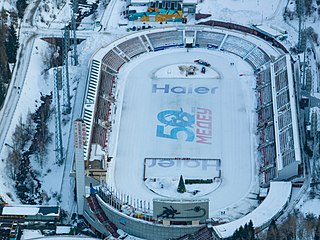
Long-track speed skating, usually simply referred to as speed skating, is the Olympic discipline of speed skating where competitors are timed while crossing a set distance. It is also a sport for leisure. Sports such as ice skating marathon, short-track speedskating, inline speedskating, and quad speed skating are also called speed skating.

Adrianus "Ard" Schenk is a former speed skater from the Netherlands, who is considered to be one of the best in history. His first Olympic success came in 1968, when he won a silver medal at the 1968 Winter Olympics. Between 1970 and 1972 Winter Olympics, Schenk won three consecutive World Allround Speed Skating Championships. He won three gold medals at the 1972 Winter Olympics, becoming, along with Galina Kulakova of Soviet Union, the most successful athlete there.

Vikingskipet, officially known as Hamar Olympic Hall, is an indoor multi-use sport and event venue in Hamar, Norway. It was built as the speed skating rink for the 1994 Winter Olympics, and has since also hosted events and tournaments in ice speedway, motorcycle speedway, rally, association football, bandy, ice sledge speed racing, flying disc and track cycling. The arena is also used for concerts, trade fair and the annual computer party The Gathering. It is the home arena of Hamar IL bandy team. The venue is owned by Hamar Municipality, and along with Hamar Olympic Amphitheatre is run by the municipal Hamar Olympiske Anlegg. Vikingskipet has a capacity for 10,600 spectators during sporting events and 20,000 during concerts.

The Medeu, is an outdoor speed skating and bandy rink. It is located in a mountain valley on the south-eastern outskirts of Almaty, Kazakhstan. Medeu sits 1,691 metres above sea level. It consists of 10.5 thousand square meters of ice and utilizes a sophisticated freezing and watering system to ensure the quality of the ice.
The Adelskalender in skating is a ranking for long track speed skating based on skaters' all-time personal records for certain distances. As in samalog competitions, the skater's time for each distance is divided in 500 metre averages, truncated to 3 decimal places, and the results are then added up – the lower the sum, the better. The samalog system was introduced in 1928 in Norway, replacing ranking points in the traditional 4 distance championships, and can also be used to reconstruct scores based on personal records that were set before the samalog system was invented.

Christina ("Stien") Wilhelmina Baas-Kaiser was a Dutch speed skater.

Nina Andreyevna Statkevich is a former speed skater who competed for the Soviet Union.
The International Skating Union has organised the World Allround Speed Skating Championships for Women since 1936. Unofficial championships were held in the years 1933–1935.

Johanna ("Ans") Schut is a former ice speed skater from the Netherlands.
The International Skating Union has organised the World Sprint Speed Skating Championships for Women since 1970. The first two years, they were called the ISU Sprint Championships.

Lyudmila Yevgenyevna Titova is a retired Russian speed skater.

Maria Grigoryevna Isakova, nicknamed Cinderella of Vyatka, was a World Champion speed skater. She was born in Vyatka, Russian SFSR, and competed for the Soviet Union.
Sergey Vasilyevich Marchuk was a Russian speed skater.

The 2011 World Allround Speed Skating Championships was held at the indoor ice rink of the Olympic Oval in Calgary, Alberta, (Canada) on 12 and 13 February 2011.

The 2014 World Allround Speed Skating Championships took place at the indoor ice rink of the Thialf arena in Heerenveen, Netherlands, on 22–23 March 2014.
The 2014–15 ISU Speed Skating World Cup, officially the Essent ISU World Cup Speed Skating 2014–2015, was a series of international speed skating competitions that ran the entire season. The season started on 14 November 2014 in Obihiro, Japan, and ended with the final on 22 March 2015 in Erfurt, Germany. In total, seven competition weekends were held at six different locations, twelve cups were contested, and 80 races took place.
The 2015–16 ISU Speed Skating World Cup, officially the ISU World Cup Speed Skating 2015–2016, was a series of international speed skating competitions that ran the entire season. The season started on 13 November 2015 in Calgary, Alberta, Canada, and ended with the final on 13 March 2016 in Heerenveen, Netherlands.
The 2016–17 ISU Speed Skating World Cup, officially the ISU World Cup Speed Skating 2016–2017, was a series of international speed skating competitions that ran the entire season. The season started on 11 November 2016 in Harbin, China, and ended with the final on 11 March 2017 in Stavanger, Norway.

Zofia Nehringowa was a Polish long track speed skater in the late 1920s and 1930s.
The 42nd edition of the World Allround Speed Skating Championships for Women took place on 6 and 7 February in Sainte-Foy, Quebec City at the Gaétan-Boucher ice rink.











